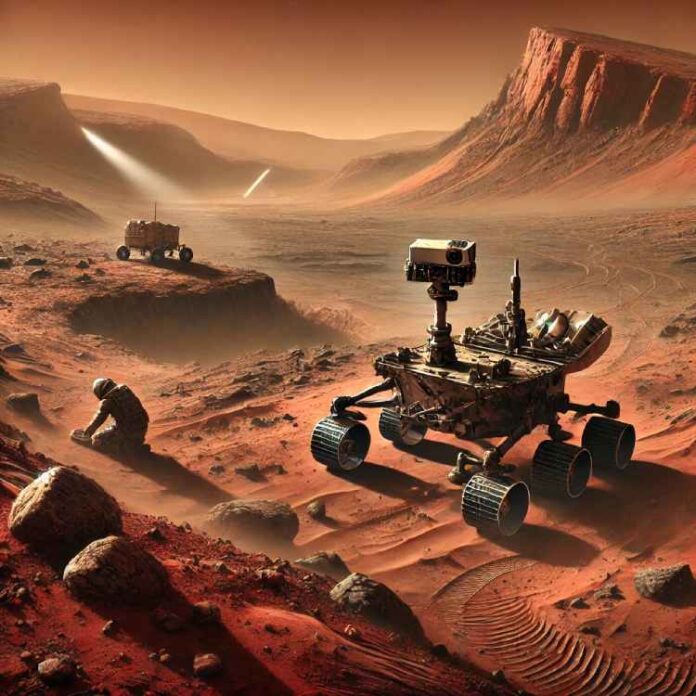Mars has long captivated the imagination of scientists and the general public alike, with its tantalizing hints at harboring past life and its potential as a future home for humanity. Thanks to several advanced rovers, we’ve been able to explore the Martian landscape, collect valuable data, and make significant discoveries. Let’s take a look at the active rovers on Mars, their most exciting findings, and what they are currently doing.
1. Perseverance Rover (2021 – Present)
Mission: Launched by NASA in 2020 and landed in Jezero Crater in February 2021, Perseverance is part of the Mars 2020 mission. This rover was designed to seek signs of ancient life and collect soil and rock samples for future return to Earth.
Most Interesting Discovery: One of the most exciting finds by Perseverance has been the detection of organic molecules in rock samples. These molecules could potentially indicate that Mars once had conditions favorable for life. Perseverance also captured breathtaking images of Martian sunsets, dust storms, and diverse rock formations, which provide new insights into the planet’s geologic history.
What It’s Doing Now: Perseverance continues to explore the Jezero Crater, an ancient lake bed. Currently, it’s conducting the first stage of the Mars Sample Return mission. The rover is collecting core samples of Martian rock and soil, which will eventually be sent back to Earth by future missions. Perseverance is also working alongside the Ingenuity helicopter, conducting aerial reconnaissance to scout terrain for its exploration.
2. Curiosity Rover (2012 – Present)
Mission: Launched in 2011 and landed on Mars in 2012, Curiosity is part of NASA’s Mars Science Laboratory mission. It is tasked with investigating the planet’s climate, geology, and the potential for past life.
Most Interesting Discovery: One of Curiosity’s most groundbreaking discoveries was the detection of methane in the Martian atmosphere. On Earth, methane is often produced by living organisms, sparking renewed speculation about the possibility of microbial life on Mars. Curiosity also found evidence that liquid water once flowed on Mars, further supporting theories that the planet may have been habitable in the past.
What It’s Doing Now: Curiosity is currently climbing Mount Sharp, a 5-kilometer-high mountain within Gale Crater. As it ascends, it’s examining different layers of rock, providing a window into billions of years of Martian history. Curiosity’s observations are helping scientists understand the planet’s transition from a wet environment to its current dry and cold state.
3. Zhurong Rover (2021 – Present)
Mission: China’s first Mars rover, Zhurong, landed on Mars in May 2021 as part of the Tianwen-1 mission. It is tasked with exploring Utopia Planitia, a large plain in the northern hemisphere of Mars.
Most Interesting Discovery: Zhurong has provided detailed data about the surface structure and composition of Utopia Planitia. It has detected signs of subsurface ice, which could be a valuable resource for future human missions to Mars. Zhurong has also measured Martian winds and provided detailed imagery of its surroundings, contributing to our understanding of the planet’s weather and surface conditions.
What It’s Doing Now: Zhurong is still operational, conducting geological surveys and studying the atmosphere and climate of Mars. Although its activities have slowed due to seasonal Martian weather, the rover is expected to resume full exploration soon.
4. Inactive Rovers: The Legacy
Several rovers have completed their missions but left a lasting legacy:
- Spirit Rover (2004-2010): Spirit made significant discoveries, including evidence of ancient volcanic activity and hot springs on Mars. It got stuck in soft soil in 2009 and ceased communication in 2010.
- Opportunity Rover (2004-2018): Opportunity made history by operating for nearly 15 years, far beyond its planned 90-day mission. It discovered evidence that water once existed on the surface of Mars. Its mission ended after a global dust storm in 2018 blocked its solar panels.
- Sojourner Rover (1997): Sojourner was the first successful Mars rover and demonstrated that robotic exploration of Mars was possible. Though its mission was short, it provided valuable data on Martian soil and atmosphere.
Why Mars Matters
The exploration of Mars offers humanity crucial insights into the past, present, and future of the Red Planet. Mars rovers have found evidence of water, organic molecules, and possible methane emissions—important signs that Mars may once have supported life. These findings not only advance our scientific understanding of the planet but also bring us closer to answering one of humanity’s greatest questions: Are we alone in the universe?
As these rovers continue to send back data, the dream of one day setting foot on Mars becomes more tangible. The discoveries they make could shape the future of space exploration and lay the groundwork for human colonies on Mars.
What’s Next for Mars Exploration?
The journey to Mars is far from over. Future missions, including the Mars Sample Return mission and potential human expeditions, will continue to build on the work of these rovers. Perseverance’s ongoing sample collection and Curiosity’s geological studies are crucial steps toward bringing Martian soil back to Earth for detailed study.
Additionally, Zhurong’s findings about subsurface ice could be pivotal for sustaining human life on Mars. The possibility of extracting water from Martian ice opens new avenues for life support systems, agriculture, and fuel production on Mars.
The legacy of Mars exploration is a testament to human ingenuity, perseverance, and curiosity. As we move forward, the findings from these remarkable rovers will continue to inspire new generations of scientists and explorers, driving us closer to unlocking the mysteries of Mars and beyond.
By Tecific.com, your gateway to cutting-edge science and technology.




